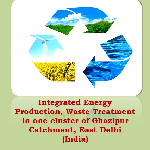Pitch
Energy Security in 21st Century needs Hybrid model with; Top-down and bottom-up approach to meet environmental and economic Sustainability.
Description
Summary
The Integrated Energy Production & Waste Treatment Project (IEP&WT) - FOR BIOGAS BUSS PROJECT is a study based project proposal to highlight the potential of converting cattle dung and vegetable waste produced in Ghazipur catchment area into renewable energy.
Biogas based Waste-to-energy (WTE) plants are systems that use a bacteriological process called anaerobic digestion to convert organic waste into biogas.
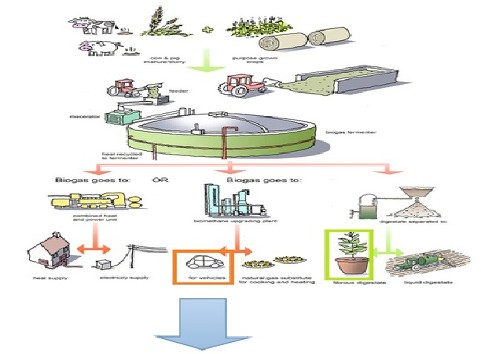
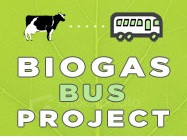
Different economic activities in dairy complex and vegetable & flower market of Ghazipur catchment area, Delhi (India) is producing approx. 147807kg of dung waste from about 13,437 dairy cattle and approx. 8700kg of vegetable & flower waste on daily basis. The organic wastes from both the units (dairy complex & vegetable market) are broken down by bacterial action in a series of stages that result in the formation of CH4(methane) and CO2. The Global warming Potential (GWP) of methane (CH4) is 72 over a 20 years period or in other words methane is 72 times stronger than CO2.
Biogas as a source of renewable energy has made three fold contribution in climate protection:
- Preventing the discharge of CH4 in the atmosphere;
- Replacing fossil fuel with clean fuel sources;
- Replacing Chemical Fertilizer by proving manure to Horticulture department of municipal corporation
Technological sustainability:
- Disseminating technological knowledge and know-how by introducing state-of-the-art technology adapted to local circumstances;
- Promoting technology transfer and encouraging further project development by demonstrating the feasibility of such a bioCNG based WTE plant in India.
The energy potential of readily available organic material in Ghazipur Dairy Cluster and Vegetable market is estimated at 393105kg (at 75% of PLF) of bio-CNG equivalent to 519645ltr of diesel or 528606 kg of coal per year.
The proposed project is a considerable example of centralized anaerobic co-digestion plant of Sustainability for BIOGAS BUS PROJECT.
Category of the action
Reducing emissions from waste management
What actions do you propose?
A. GENERAL INFORMATION OF PROPOSED BioCNG BASED Waste-to-Energy PLANT IN GHAZIPUR DAIRY COMPLEX
Project Activity: In the Ghazipur Dairy cluster the project proponent intends to build 3116 cubic meter Biogas & fertilizer plant as a part of the proposed Greenfield project activity. Through this project activity the amount of greenhouse gases emitted into the atmosphere will be reduced.
Pre-Project Scenario: In the pre-project scenario, about 85-90% of dung produced on daily basis from Ghazipur dairy (dairy cows & dairy buffalos) are washout into open drain and remaining 10-15% will be used for preparing dung-cakes (upale) or wasted in open drying yard where it is allowed to further degrade.
Organic waste generated from Ghazipur vegetable & flower market has no sustainable solution. As per primary study about 8000 kg (i.e. 7000 kg from vegetable & fruit market and 1000kg from flower market) organic waste is generated from these markets are transported to Ghazipur landfill site where it further degrade and contributes in emission of CH4 in local and global environment. Both these source release CH4 (methane) into the atmosphere, unless treated in waste-to-energy plants such as proposed project activity.
Post-Project Scenario: In the post-project scenario, the project proponent procures dung from approximately 347 operational dairies and vegetable & flower waste from Ghazipur vegetable & flower market. The dung and vegetable & flower waste will be collected on daily basis and will be delivered to a substrate storage area at site and is off-loaded onto a scraper floor for continuous feeding into stirred digesters. Under controlled conditions biogas is produced through bio-methanation process, which recovers the methane (biogas) from the litter. The biogas which is further converted into BioCNG/CBG by removing carbon dioxide, Hydrogen Sulfide, moisture can be compressed into cylinders and make it easily available for transportation and stationary application in nearby Eastern Delhi market. Today CNG technology has became easily available for waste-to-energy projects, bio-menthe (enriched biogas) which is nearly the same as CNG, can be used for all applications for which CNG are used.
Proposed Capacity of the Project (on daily basis)
a) Quantity of inputs to be procured (on daily basis);
- Dung from Ghazipur Dairy:- 73903 kg
- Organic waste from Vegetable & flower Market : 4000 kg
Fig 1. BLOCK WISE DAIRY COMPLEX DETAILS
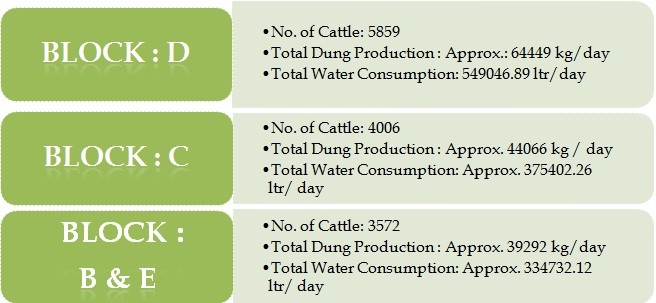
b) Bio-gas generation;
Types of Inputs: Cubic Meters (on daily basis)
- Dung + Vegetable & flower Organic waste - 3116 m3
C) Bio-fertilizer/manure production(per day): 12741.6 kg
B. TECHNICAL COMPONENT OF PROPOSED BGFP PLANT IN GHAZIPUR DAIRY COMPLEX
1. Availability of cattle dung/ organic waste from vegetable market
- Identification of raw material like cattle dung, biomass, food and market waste, etc.
- Collection transport, storage, shelf life requirement
2. Details of Cattle dung & Organic waste generated in
Ghazipur catchment area
- Cattle & buffalo Dung
from Dairy - 147807 (per day) & 53949555 (per annum)
- Vegetable & Fruit waste + Flower waste- 7500+ 1200 (per day) & 2737500 + 438000 (per annum)
3.Details of Cattle dung & Organic waste for Proposed Plant
- Cattle & buffalo Dung from Dairy- 73903 kg (per day) & 26974778 kg (per annum)
- Organic feed material- 4000 kg (per day) & 146000 kg (per annum)
In the proposed project activity, emission reduction specific to methane avoidance will be claimed for both cattle dung and organic waste (vegetable & flower waste).
4. Biogas Technology;
Biogas Induced Mixing Arrangement (BIMA) Digester Technology
Given below schematic diagram of BIMA Technology based Biogas & Fertilizer (BGF) Plant illustrates diagrammatic view of Waste-to-Energy process.
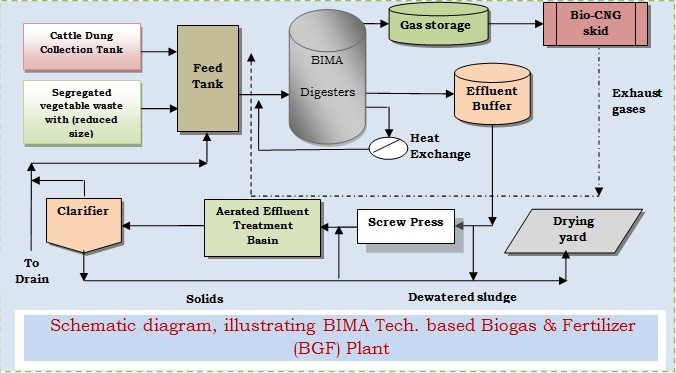
Fig. 2. Schematic diagram
5.Major Component of Biogas plant
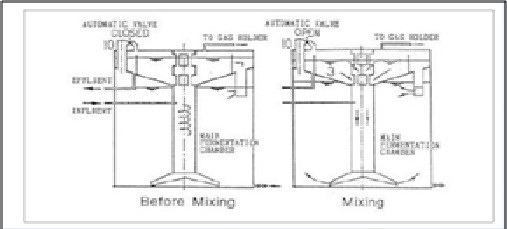
Fig. 3. Working Principal of BIMA Digester
- Collection Tank & Dry well
- BIMA Digester
- Effluent buffer tank
- De-watering station
- Drying yard
- Effluent Treatment Plant
- Gas Holder & Gas blowers
- Bio-CNG skid
- PLC Scada System
- Electrical control Room
- Outdoor Yard
- Fire Fighting System
6. Process Flow and its Description
PROCESS FLOW:
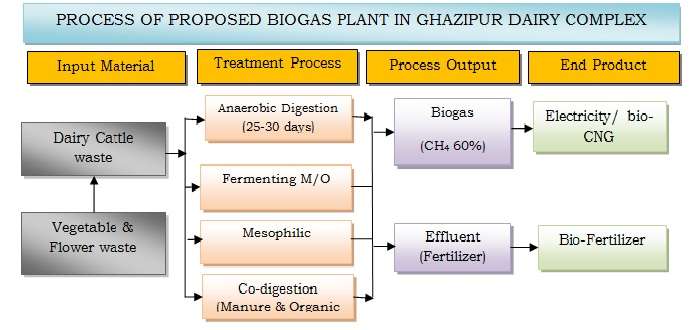
Fig.4. Process Flow
PROCESS DESCRIPTION:
6.1. Waste Handling & Slurry Preparation Section (Vegetable Market Waste):
a. Receiving Area: The waste collected from the vegetable market is brought to the existing transfer station where packing material and silts are removed. The waste free from plastics, cloth, stones, slit and other impurities is transferred to the receiving area and collected at the receiving platform.
b. Waste Handling: On the receiving platform, a mechanical handling system namely “Grab” with traveling electric hoist is provided to handle the received waste and the walkway is provided for the person to handle the Grab. The waste is transferred by the Grab to the feeding hopper of the conveyor and transferred through the conveyor for size reduction.
c. Waste Segregation: The waste being carried through the conveyor is sorted by persons standing on the supporting platforms parallel to the conveyor. Substances such as plastics, clothes, wood, stones, which are not biodegradable, are removed.
d. Ferrous Separation: Magnetic separator is provided parallel to the conveyor so that the iron (ferrous) materials, if any, which would get stuck to the magnetic separator and the iron materials are removed manually and stored in the bins for sale/Disposal.
e. Size Reduction: The waste will be delivered into the Shredder to reduce the wastes to uniform size of around 15 - 20 mm. Shredder has knives which cuts the wastes into small particles. The shredder can process about 4 tones /h. After size reduction wastes will be transferred into a tank.
6.2. Ghazipur Dairy Waste (Cattle & Buffalo waste):
The cattle and Buffalo dung will be collected from approx. 347 operational dairies on daily basis through tractors and brought near the loading dock on to the ramp and the dung waste is unloaded. The animal dung is blended in a collection tank.
6.3. Dissolution (Homogenization of Raw Manure):
The animal dung and shredded vegetable waste is blended in a collection tank/ Feed tank to provide a waste of uniform characteristics, and a waste feed with a solid concentration not exceeding 10%.
6.4. Anaerobic Digestion:
Process of Anaerobic Digestion is based on above mentioned technology; Biogas Induced Mixing Arrangement, BIMA Digester Technology. The main advantage of BIMA digesters is its mixing system (it doesn’t require mechanical moving parts), ability to control scum/sediments and handle high solids concentration. A biological desulphurization unit could be installed in the digester to reduce the H2S content of biogas.
6.5. BioCNG Collection:
The biogas, which is produced as a result of stabilization of the waste, leaves the BIMA digester automatically to the gas holder. The biogas consists of 55 - 65% methane (CH4) and 35-40% carbon dioxide (CO2). In place of a conventional gas holder which is prone to corrosion, a dry type gas holder made of a synthetic membrane (polyester) and suspended in a concrete silo, has been installed in the plant.
6.6. Bio-fertilizer Production:
The digested substrate leaving is dewatered through a screw press. The dried manure shows a much better availability of nutrients for the plants due to its bio-chemical composition. On daily basis Bio-fertilization plant could produce approximately 12741.6 kg of Bio-fertilizer, which can sell in the open market to farmers or horticulture department of Municipal Corporation.
7. Biogas as a Road Transport Fuel & Awareness Campaign:
Experience of Biogas as a vehicle fuel especially in Public Transport not yet started in India and other part of Sub-continent, which has around 30-35% of its population residing in Urban Centers.

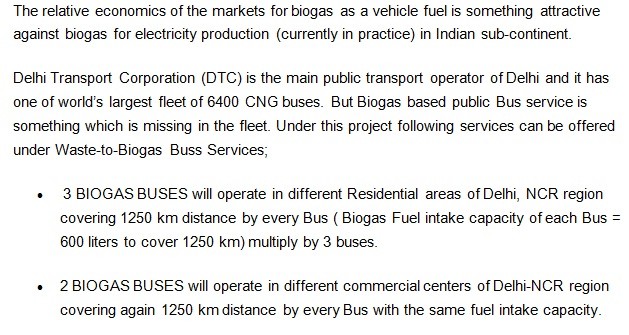
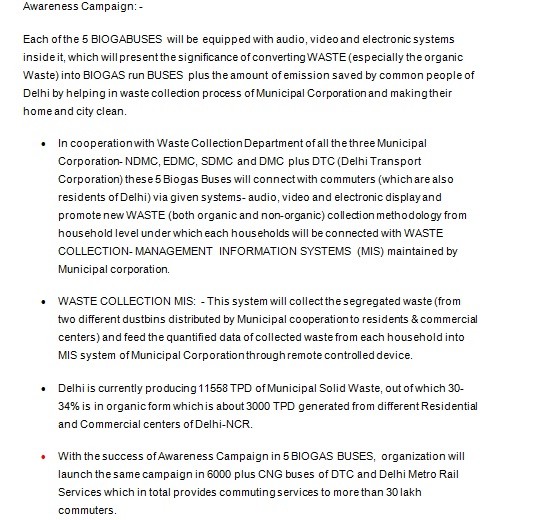
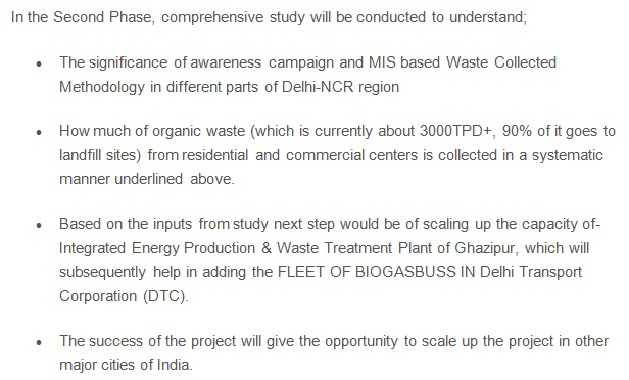
The given business model will involves several actors and institutions (highlighted below in the next section) who possibly play a key role in the implementation of the given project.
Energy and environment are two most critical policy issues for governments and policymakers in developed and developing economies. But developing countries are the one, who are seriously encountering challenges in development and management of energy and environmental economy at micro and macro level.
This given project could illustrate the significance of clean energy Hybrid model and its approach of “top-down” and “bottom-up” to meet environmental and economic sustainability of Transport Services in Delhi through Biogas Buses by utilizing different forms of organic waste.
The externalities associated with this type of waste-to-energy project under renewable energy programme could possibly be seen as a window to future of energy and environment in India and other emerging economies. The significance of renewable energy & sustainable development can be explained by given below pie chart and graph.
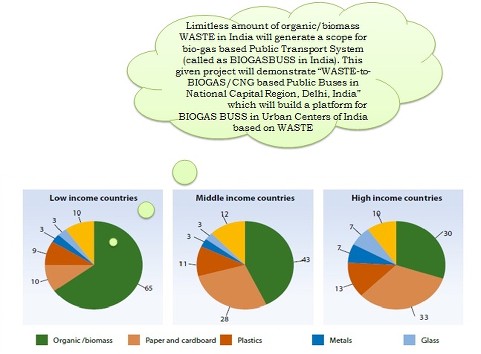 Fig. 5. Composition of MSW by National Income
Fig. 5. Composition of MSW by National Income
Above pie chart encourage the below graph from both policy and programme angle for Integrated Energy Production for BIOGAS BUS SERVICE. It suggests the significance of energy and environment.
The importance of given project in National Capital Region (NCR) and its possible positive impact on other municipal bodies is critical in shaping energy, environment and economy of emerging cities and urban centers in developing countries. Graph given below underlines the long term significance of Renewable energy and Sustainable Development policy adaptation in India and other emerging economies.

Fig. 6. Renewable Energy Policy
- With no policy adaptation on renewable/green energy sector, the vulnerability of climate change will possibly increase and its impact on societies in developing countries will be far greater than the developed world (see red color curve in Fig.above).
- Pink color curve indicates future impacts of climate change with the adaptation of renewable energy policy. The curve indicates less level of vulnerability and its impact on society and environment compare to no policy adaptation (i.e. red color curve).
- The last curve in blue color indicates the low level of impacts, where we assume no climate change in future with renewable energy policy adaptation (less likely event).
- Time line suggested under the diagram to analyze positive and negative impact of energy and environment policy is approximately 80-90 years from 2013.
- This given project is a best case for Pink color curve which indicates adaptation of clean-fuel energy economy and its minimal impact on environment.
8. Conclusion
Anaerobic digestion is a mature and proven technology that will thrive under the right market conditions. Policies supporting anaerobic digestion for BIOGAS BUSES will empower communities to develop a biogas industry that would create jobs, improve the transport services, and agriculture industry’s image and generate significant economic returns.
The proposed project has a potential to thrive from all the three given angles of Sustainable Development; environmental sustainability, economic sustainability and social sustainability.
Who will take these actions?
This given model of Waste-to-Energy will have a potential to follow; "SOCIO-TECHNICAL Regime" for Dairy Sector, which will create a platform for different stakeholders like:--
1. Financial Institutions- Ministry & Financial Agencies
2. Suppliers -Waste Recycling Companies,
3. User Groups- Dairy Cooperatives, Waste collection units),
4. Societal groups- Involvement of local communities,
5. Research Network-Technical Institutions, etc.
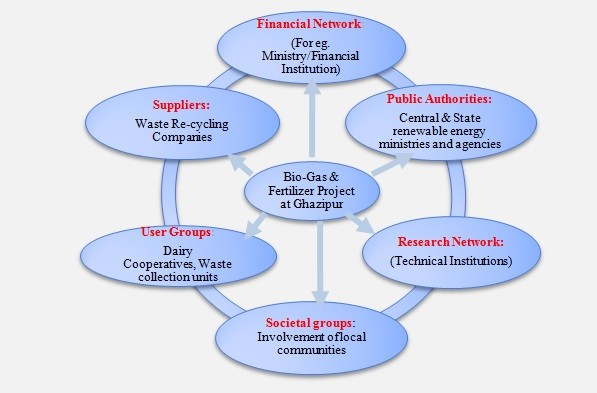
Fig. 7. Diagrammatic view of Socio-Technical Regime concept
in the treatment of organic waste by using Environmentally Sustainable Technologies (ESTs) for the suggested proposal.
Based on the different aspects of the proposal and the significance of "Socio-Technical Regime" the Ministry of New & Renewable Energy of Govt. of India will engage with different authorities and Municipal bodies underlined above for preparing a Detailed Project Report (DPR).
A team under the guidance of Ministry will start preparing Detailed Project Report (DPR) which will underline all the major and minor component of project like; back-end and front-end supply chain of the project. In short the DPR would be like a reference book for the Project Management Team who will implement the end-to-end project on ground.
Where will these actions be taken?
PROPOSED LOCATION OF THE PROJECT:
Village: Ghazipur
Tehsil / Taluka: Preet Vihar
Municipal: Khichdipur (214)
Municipal Zone: South Zone of Municipal Corporation of Delhi (MCD)
District: East Delhi
State: Delhi
Country: India
The physical location of the project activity is indicated on the maps below.
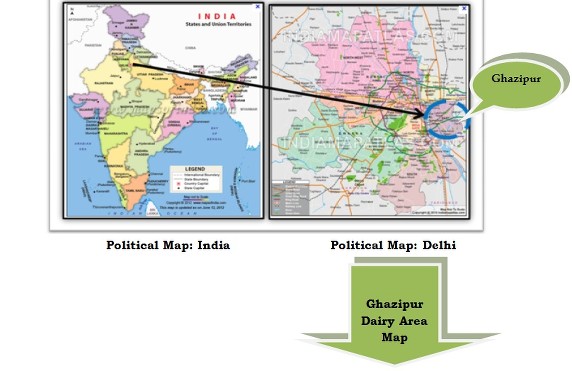
Fig. 8. Ghazipur Dairy Area Map: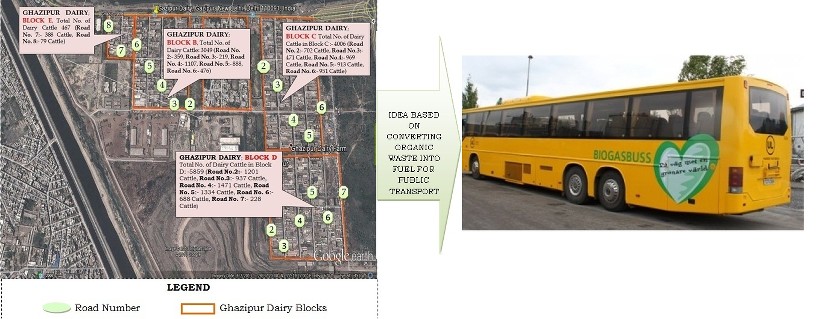
What are other key benefits?
The success of the project will be evaluated on following parameters;
1. Environmental & Social well-being:- The project activity is expected to contribute to environmental well-being by reducing carbon emission in local and global environment plus generating employment through streamlining back-end and front-end supply chain of the project.
2. Technological well-being:- Disseminating technological knowledge by introducing Environmentally Sustainable technologies adapted to local circumstances.
3. Ground water & Wastewater Management:- Graph below highlights ground water consumption due to its unsustainable consumption practice for cattle and dairy washing. With the implementation of the project water consumption level and its wastage will dramatically reduce by supplying cattle dung into plant in systematic way.
Fig.9:- Water Consumption level of Dairy
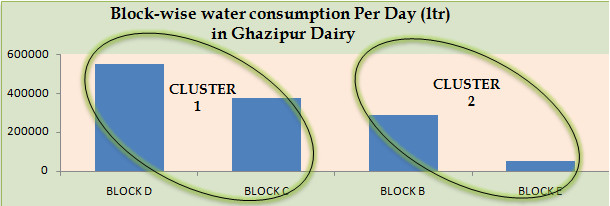
4. Waste collection Method from household level through MIS based system will be a key event in the project cycle
How much will emissions be reduced or sequestered vs. business as usual levels?
1. BUSINESS AS USUAL(BAU) SITUTATION IN GHAZIPUR CATCHMENT AREA

2. EMISSION REDUCTION & POSITIVE EXTERNALITY:- GREEN BUSINESS INTERVENTION
The proposed green energy project has a potential to bring positive impact on environmental front. Given below diagram (Green business intervention) highlights the half way reduction in the emission level which means approximately;
- 382393Gg/yr of methane from enteric fermentation,
- 28226kg/year of methane from manure management and
- 66156.25 kg of methane from organic waste generated by Ghazipur Vegetable & flower market
has been prevented to emitte in atmosphere by introducing green-energy intervention in Ghazipur catchment area.
Fig. 10 GREEN BUSINESS INTERVENTION
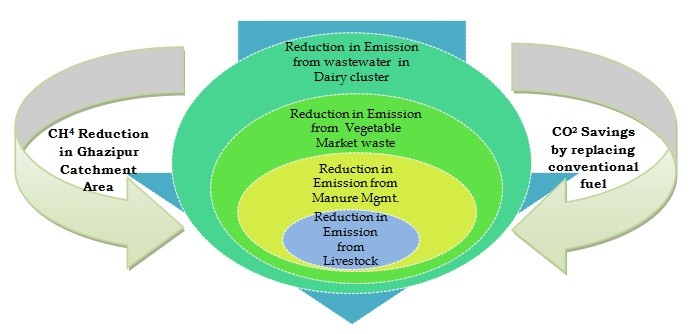
In addition to CH4 reduction (as highlighted above), the proposed “waste-to-energy” project also has a significant potential to save carbon emission into atmosphere by replacing conventional fuel with bio-energy products (See table below)
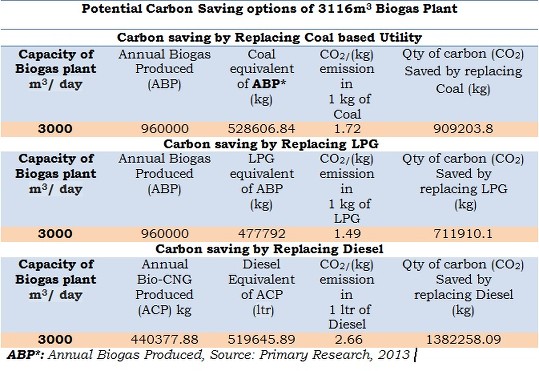
What are the proposal’s costs?
A Total of 1094167.21 US Dollar is requested for project cost and it will be used as given below Financial mechanism;
Exchange Rate is Rs. 60.54 for 1 US Dollar
i. PROJECT INVESTMENTS:-
1. Site Development- 88384.35
2. Plant & Machinery- 909304.83
3. Pre-operating expenses- 1659.8
4. Preliminary Expenses- 3319.6
5. Working Capital Margin- 19917.6
6. Contingency @ 7%- 71581.03
ii. Assumptions for Project Details:-
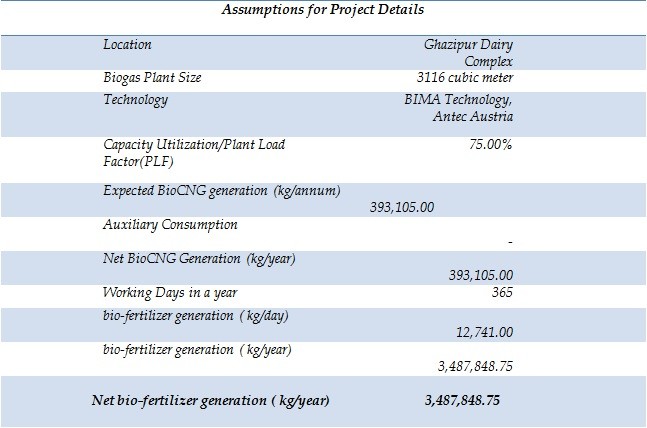
Give below are the Estimated Cost Details for Plant & Machinery (in dollar terms):-
1. Gas blower- 49794
2. Fire Fighting System - 1659.8
3. Flare System - 165980
4. Bio-CNG skid {Gas Compression/Moisture /
Siloxane and Co2 Removal System} - 414950
5. Chaff Cutter - 99588
6. Conveyor Belt - 24897
7. Screw Press - 66392
8. Inverter - 3319.6
9. Generator - 6373.63
10. Transformer - 9958.8
11. Switches - 16598
TOTAL- $ 909304.83
Details of Operating Cost/ Cost of Production:-
Estimated Cost under Human Resources:
1. Labors @ Rs. 200/ day (in dollar terms 3.32 per day)
- Number of Labor: 13
2. Labors @ Rs. 200/ day for Transportation of Feed stock (in dollar terms 3.32 per day)
- Number of Labor Transportation: 8
3. Engineer @ Rs. 30000/month ( in dollar terms 497.94 per month)
- Number of Engineer: 2
4. Accountant @ Rs. 15000/month (in dollar terms 248.97 per month)
- Number of Accountant: 1
Estimated Cost for Raw Materials:
1. Cattle Dung @ Rs. 120/ tonne (in dollar terms 2 dollar per tonne with 3% of escalation)
Qty required per day- 74 tonne
2. Vegetable & Flower Waste (Qty required)- 4 tonne per day (No payment required)
3. Water( litter / day)- 80000
4. Electricity - 400 kW/ day
iii. IRR & DSCR:-
Internal Rate of Return
1. Equity- IRR: 19.36%
2. Project-IRR: 16.03%
Debt Service Coverage Ratio
1. Average DSCR (10 years)- 1.65
2. Minimum DSCR- 1.26
3. Maximum DSCR- 1.76
IV. Preforma Profit & Loss in INR ( for 11 years)

THE COST FOR MIS-WASTE COLLECTION TECHNOLOGY + DEVICE FETING IN BIOGAS & OTHER CNG BUSES AND DELHI METRO WILL BE ANALYZED IN DPR FOR THE BETTERMENT OF THE PROJECT
Time line
The Integrated Energy Production & Waste Treatment Project (IEP&WT)- FOR BIOGAS BUS PROJECT will be implemented on the bases of given below matrix, which will emphasize on sustainability (parameters are marked on horizontal axis) of 5 stage Project Life ( marked on vertical axis).

Each stages of the project will be guided and executed by specialized project management team.
THIS IS TRUE THAT, THE CONCEPT OF "WASTE-TO-ENERGY" CAME INTO PICTURE SOMETIME BACK BUT FOR MORE THAN 75000 RESIDENTS LIVING IN THE GHAZIPUR CATCHMENT AREA, WHO STRUGGLES ON DAILY BASIS FROM NEGATIVE EXTERNALITIES LIKE- DAIRY WASTE, POLLUTED WATER, HEALTH RELATED ISSUES, DECREASE IN GROUND WATER TABLE OF CATCHMENT AREA WILL HAVE A SIGNIFICANT EFFECT ON SUSTAINABILITY OF HABITAT IN DAIRY COMPLEX & GHAZIPUR CATCHMENT AREA.
THEREFORE, THE GIVEN PROJECT WILL GIVE A NEW SHAPE TO DAIRY BUSINESS + WASTE-TO-ENERGY CONCEPT + BIOGASBUS DRIVE IN NATIONAL CAPITAL REGION OF INDIA + THE MIS BASED WASTE COLLECTION SYSTEM (A NEW APPROACH) AND A GUIDANCE FOR OTHER URBAN CENTERS OF INDIA IN NEAR FUTURE IN MAKING CITY SUSTAINABLE AND SMART FROM THE CONCEPT OF- INTEGRATED WASTE MANAGEMENT.
Related proposals
1. Using Biogas Technology To Improve Sanitation And Mitigate Climate Change, is underlining the criticality of Environmentally Sustainable Technologies (ESTs) and the concept of sustainable energy.
References
1. K. Sri Bala Kameswari, B. Velmurugan, K. Thirumaran and R.A. Ramanujam; Biomethanation of Vegetable Market Waste – Untapped Carbon Trading Opportunities
2. Reported from igovernment; http://www.igovernment.in/site/haryana-plans-set-commercial-biogas-plants-37593
3. Reported from Maharashtra government site; http://envis.maharashtra.gov.in/envis_data/files/MSW
4. Reported from MNRE(Indian government ministry of Renewable Energy) website; http://mnre.gov.in/energy-iwaste.htm
5. Reported from Project Design Document form of UNFCCC; IOT_Mabagas_PDD_02Dec11
6. 2006, IPCC Guidelines for National Greenhouse Gas Inventories
7. Mahadeswara Swamy & Sumana Bhattacharya, 2006
8. MNRE,http://pib.nic.in/newsite/erelease.aspx?relid=92437
9. IREDA,http://www.ireda.gov.in/forms/contentpage.aspx?lid=821
